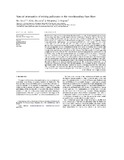Natural attenuation of mining pollutants in the transboundary Save River

View/
Date
2011Author
Meck, M.L.
Masamba, W.R.L.
Atlhopheng, J.
Ringrose, S.
Publisher
Elsevier Science Ltd, http://www.elsevier.com/locate/pceType
Published ArticleMetadata
Show full item recordAbstract
The objective of the study was to investigate the role played by the natural environment in protecting the
transboundary Save River from the impacts of metals derived from phosphate mining at Dorowa. The
study is a follow up study from a previous one that noted that there is natural attenuation at Dorowa. Water and sediment samples were collected in the Save River and the streams that drain the Dorowa dumps. Inductively coupled plasma mass spectrometry (ICP–MS) was used to analyze the cations (Na+, K+, Ca2+, Mg2+, Cu2+, Co2+, Fe2+, Ni2+, Zn2+, Pb2+, Sn2+, Mn2+, Cd2+) in the samples. Major anions Cl , SO2 4
and NO 3 were analyzed by standard chromatography whilst CO2 3 and HCO 3 were determined by titration. pH was measured on site. Geochemical modeling of the water composition was conducted with
Visual Minteq. The results show that natural attenuation is being achieved through precipitation of solids from the water and subsequent deposition onto the sediments. Six of the metals are almost completely
precipitated (Cu 99.99%, Fe 99.39%, Ni 91.24%, Pb 99.87%, Sn 99.99% and Zn 88.66%). However Mn, Co and
Cd remain in solution. Thus the natural environment is protecting the Save River which is a transboundary
river from the impacts of mining through precipitation of the metals. Users downstream of Dorowa
mine are therefore not being affected by mining pollution. This study demonstrates that besides being a
legitimate and important user of water, the natural environment can also play a significant role in protecting water quality by attenuating metals naturally. By analyzing costs incurred in several places where
alternative methods are employed to remediate metal related pollution the study concludes that natural
remediation at Dorowa is saving the nation in environmental costs. Therefore the paper advocates for appreciation of the role that the natural environment plays in protecting ecosystems from the impact of human developments and environmental costs. Subsequently, this calls for recognition of natural environment’s
role in water resources management for the sustenance of ecosystems and peoples livelihoods.
